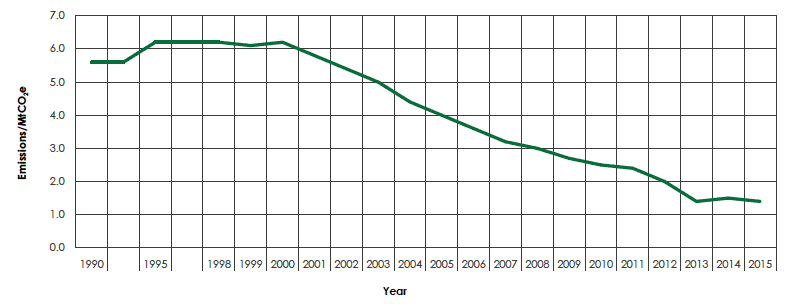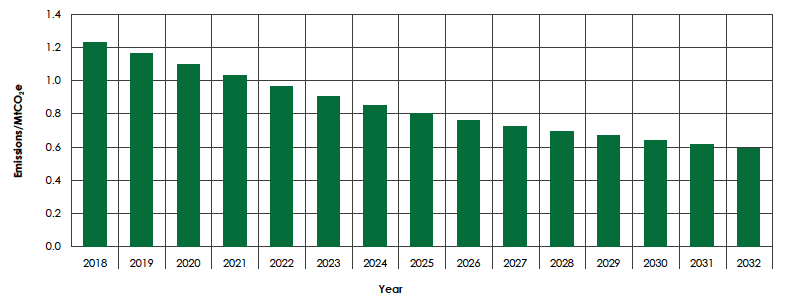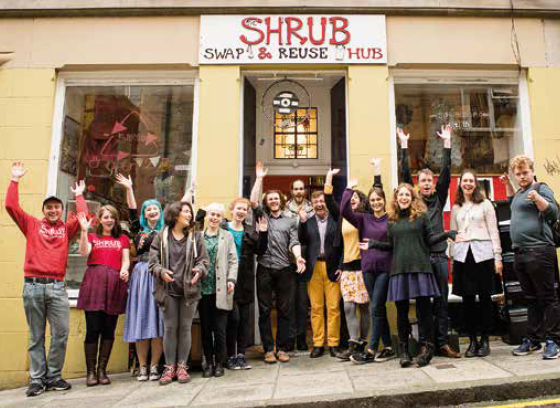Climate Change Plan: third report on proposals and policies 2018-2032 (RPP3)
This plan sets out the path to a low carbon economy while helping to deliver sustainable economic growth and secure the wider benefits to a greener, fairer and healthier Scotland in 2032.
Chapter 5 Waste
The waste sector covers the use of resources, including maximising the reuse, recycling and recovery of resources where products and materials are kept in high value use for as long as possible.
Where We Are Now
- 75% fall in waste sector emissions between 1990 and 2015
This sector has seen a 4.2 MtCO 2e (75%) fall in emissions between 1990 and 2015. This is a result of the progressive introduction of landfill gas being captured and used for energy and the ongoing reduction in biodegradable municipal waste going to landfill. Other factors may contribute to this reduction, including improvements in the standards of landfill and changes to the types of waste going to landfill. Between 2014 and 2015 the sector saw a 4% fall in emissions.
Figure 15: Waste historical emissions

Progress Since RPP2
Since RPP2 was published, most of the legislative proposals from the Zero Waste Plan have come into effect, with new legal requirements for separate collection of food and recyclable waste from households and businesses. Key achievements include the following:
- The amount of waste from all sources landfilled in Scotland fell from 4.1 million tonnes in 2013 to 3.7 million tonnes in 2016.
- Resource Efficient Scotland [108] provides practical, on-the-ground support to help businesses eliminate unnecessary waste (water, energy and materials), save money and retain a competitive edge.
- 1.95 million households (80% of total households) now have access to a food waste collection service, up from around 575,000 in 2013.
- Since 2013, food waste processing capacity (anaerobic digestion and composting) has increased from around 230,000 tonnes per year to around 365,000 tonnes per year in 2017.
- Scotland's household recycling rate was 45% in 2016 – up from around 42% in 2013. In 2016, 14 councils had a recycling rate in excess of 50%, and East Renfrewshire council became the first Scottish council to surpass 60%.
Following installation of gas capture equipment at two closed landfill sites in the Scottish Borders, similar gas capture technology is being installed at two additional sites in Glasgow and East Lothian.
Our Ambition
Figure 16: Waste Emissions Envelopes

Emissions are expected to fall by 0.6 MtCO 2e (52%) over the lifetime of the Plan.
The Scottish Government's ambition for a circular economy is set out in its strategy, Making Things Last [109] . By 2035, we expect the principles of a circular economy to be well established across Scotland. We want more products designed for longer lifetimes, second hand goods to be seen as a good value, mainstream option, and major industrial sectors to be optimising the value of used equipment, such as the reuse of elements of energy infrastructure. As landfilling decreases, the Scottish Government will help to manage the legacy of landfill sites around Scotland, minimising emissions from operational and closed sites, through the use of flaring technology.
- Ending landfilling of biodegradable municiple waste by January 2021 and reducing the percentage of all waste sent to landfill to 5% by 2025.
- By 2025, we expect to reduce food waste by 33%, and to recycle 70% of all waste, in line with our targets.
- By 2035, we aim to be delivering emissions reductions through a circular economy approach in our business and industry sectors.
In Waste Sector, We Aim to
- recycle 70% of all waste by 2025
- by 2021 we will end landfilling of biodegradable municipal waste
- establish a more circular economy
- reduce all waste sent to landfill to 5% by 2025
- achieve 33% reduction of food waste by 2025
- reduce emissions from closed landfill sites
Policy Outcomes, Policies, Development Milestones and Proposals
Policy outcome 1:
Reduction in waste sent to landfill.
There are four policies and one proposal which will contribute to the delivery of policy outcome 1.
The four policies are related to the delivery of our suite of waste reduction, recycling and landfill diversion targets and regulation up to 2025.
The Scottish Government has set out its priorities for action in Making Things Last, our circular economy strategy. We fund Zero Waste Scotland as the main circular economy expert and delivery partner, supporting businesses, local authorities and communities to act. The enterprise agencies also have an important role through mainstream business support; as do local authorities through their responsibilities for waste and recycling; and Scottish Environment Protection Agency ( SEPA) as regulator. The Scottish Government budget in 2016‑2017 was £20.4 million for waste and circular economy measures to reduce waste and encourage recycling, resuse and remanufacture and reduce the requirement to landfill waste. Actions were also taken to minimise emissions from historic landfill sites.
Delivery will be achieved through a combination of:
- Regulation, including requirements for business and local authority recycling and a ban on biodegradable municipal waste going to landfill.
- Targeted funding and the Scottish Landfill Tax.
- Support for business, local authority and community action.
The four policies below set out in more detail how policy outcome 1 will be delivered.
1) Target to recycle 70% of all waste by 2025.
The Scottish Government will work with a range of public and private partners to deliver this target. Local authorities, waste management companies and other businesses have duties to segregate food waste and other materials for recycling. We will continue to look for ways to support and strengthen recycling and food waste services in rural areas and island communities.
The Scottish Government has agreed the Household Recycling Charter with COSLA [110] , which will introduce more consistent local collections, making it easier for people to recycle, therefore improving the quantity and quality of recycling. Delivery of this action is supported by funding from Zero Waste Scotland.
Through Zero Waste Scotland we are supporting local authorities to implement food waste collection and change their recycling collections in line with the Household Recycling Charter. This support is in addition to the funding that councils receive through the local government settlement.
The Programme for Government 2017‑2018 set out the Scottish Government's intention to introduce a Deposit Return Scheme, which will improve both the quantity and quality of recycling of the materials collected. We will go further in our efforts to end Scotland's 'throw-away' culture, by examining how to reduce demand for single-use items, such as disposable coffee cups. The Scottish Government will appoint an expert panel to advise on the use of fiscal or other measures, similar to the successful single-use plastic bag levy, with the goal of encouraging long-term changes in consumer behaviour.
'Making Things Last – a Circular Economy Strategy for Scotland' sets out our priorities for moving towards a more circular economy – where products and materials are kept in high value use for as long as possible. It builds on Scotland's progress in the zero waste and resource efficiency agendas. A more circular economy will benefit:
- the environment – cutting waste and carbon emissions and reducing reliance on scarce resources;
- the economy – improving productivity, opening up new markets and improving resilience; and
- communities – more, lower cost options to access the goods we need with opportunities for social enterprise.
2) Target to reduce food waste by 33% from the 2013 baseline by 2025.
The Scottish Government is considering a comprehensive Food Waste Action Plan to achieve the target, to be published in 2018. This plan could include legislative measures that would need to be consulted on. The Scottish Government will clarify the timescales for any consultation once the plan is published.
3) Ending landfilling of biodegradable municipal waste by January 2021 and reducing the percentage of all waste sent to landfill to 5% by 2025.
A ban on the landfilling of biodegradable municipal waste ( BMW) is due to come into force from January 2021. The Scottish Government will work with stakeholders to help address challenges associated with the 2021 deadline for banning BMW to landfill, and SEPA will provide guidance to councils and private operators on the administration of the ban and seek assurances on their plans for compliance.
Energy from waste plants has a role in managing residual BMW. The Scottish Government will seek to ensure that waste is treated appropriately and in line with the waste hierarchy set out in our circular economy strategy, helping by continuing to ensure that only appropriate material will be used for energy recovery.
The Scottish Landfill Tax already provides an incentive to reduce landfilling and prioritise more valuable options such as waste reduction and recycling.
The Scottish Government will work with SEPA and Zero Waste Scotland to continue to improve the way that we provide and present information on the anticipated capacity requirements for future alternative waste infrastructure, for use by planning authorities and industry. This will help to ensure that the capacity of waste infrastructure developed is appropriate.
4) Reduce waste and establish a more circular economy, where goods and materials are kept in use for longer.
The Scottish Government will achieve this policy through the delivery of Making Things Last, and our targets to reduce all waste by 15% and food waste by 33% by 2025. Delivery mechanisms will include:
- Resource Efficient Scotland [111] – helping businesses reduce food and construction waste.
- The Courtauld 2025 [112] agreement with food businesses to cut food waste by 20%.
- The Circular Economy Investment Fund and Service [113] – helping companies transform their business models to design out waste.
Policy proposal
1) We will work with our partners to identify further opportunities for the circular economy to contribute to the implementation of the Climate Change Plan.
The Scottish Government believes that further development of the circular economy is important as we move towards a low carbon world. A more circular economy will contribute to our targets by reducing both the emissions needed to treat waste and also the emissions created from the manufacture of products in the first place.
While the targets in Making Things Last run to 2025, this proposal recognises the need to develop a strategic approach in the future.
Case Study
Team of volunteers at the Swap and Reuse Hub – SHRUB in Edinburgh

Credit: Zero Waste Scotland
The Swap and Reuse Hub ( SHRUB) is led by the student community and aims to significantly reduce waste arising from the transient student population in Edinburgh. At the end of each student year, volunteers go into the recently vacated student accommodation and remove everything that has been left behind, including furniture, bedding, kitchen equipment, clothing, books and much more. Items either go into a 'free shop' for the next intake of students, or to SHRUB's permanent swap shop facility. All of this saves items going to landfill and also reduces the amount of items students, or the community, have to buy new. SHRUB also runs a number of workshops where people can learn to upcycle or repair items to keep them in use for longer; food sharing scheme, and events such as swap shops.
In 2015-2016, the project saved 135.5 tCO 2e - 39.5 from food sharing, 89.2 from swap and reuse activities, and 6.85 from bike repairs.
SHRUB has been awarded funding from the Scottish Government's Climate Challenge Fund ( CCF) for a range of initiatives which aim to help build a low carbon circular economy in the heart of the city. The SHRUB won the Waste Category at the inaugural CCF Awards for their work that took place in 2016-2017.
Relative significance of policies and proposal to the delivery of policy outcome 1
The majority of emissions reductions in the waste sector are a consequence of policy outcome 1. Together, the policies contribute in an integrated way to the achievement of the policy outcome.
Monitoring
Policy output indicator for policy outcome 1
1) By January 2021, the landfilling of biodegradable municipal waste will be phased out. As a result of that, and the other policy action above, we expect the volume of land filled waste to fall significantly from the current level of 3.7 million tonnes.
| Year | 2018 | 2019 | 2020 |
|---|---|---|---|
| Tonnes of waste landfilled (household and non‑household) | 2.7m | 2.3m | 2.0m |
Implementation indicators for policy putcome 1:
1) 60% of total household waste recycled by 2020.
2) 70% of all waste recycled by 2025.
3) Household and non-household food waste reduced by 33% by 2025 from 2013 baseline.
Explanation for selection of indicators
Our success in delivering a more sustainable circular economy will be demonstrated by clear changes in how we deal with waste. We have set ambitious targets to increase recycling and our world leading target to reduce food waste by 33%. Our policy action will target these indicators which will in turn drive improved environmental performance.
Policy outcome 2:
Reduction in emissions from closed landfill sites.
There is one policy and one policy development milestone which will contribute to the delivery of policy outcome 2.
Policy which contributes to the delivery of policy outcome 2
1) Landfill gas capture on closed sites.
Landfill gas capture supports climate change objectives by tackling emissions of methane, a gas which tonne for tonne is 25 times more damaging than carbon dioxide. Twelve potentially suitable sites have been identified by SEPA. Working with site managers, many of whom are from local authorities, we are supporting installation of equipment through Zero Waste Scotland drawing on SEPA expertise. A forward work programme of projects will be developed.
Policy development milestone
1) Six suitable sites under development by 2018‑2019
Relative significance of policy and policy development milestone to the delivery of policy outcome 2
Policy outcome 2 makes a smaller contribution to emissions reductions in the waste sector than policy outcome 1.
Monitoring
Policy output indicator for policy outcome 2
| Year | 2017‑2018 | 2018‑2019 | 2019‑2020 | 2020‑2021 |
|---|---|---|---|---|
| Number of additional landfill sites with gas capture being developed each year | 3 | 6 | 9 | 12 |
Implementation indicator that contributes to the delivery of policy outcome 2
1) Up to 12 landfill gas capture sites supported by 2020‑ 2021.
Explanation for selection of indicator
We will work with our partners in the public and private sectors to ensure that all sites confirmed by SEPA as being suitable for landfill gas capture have equipment installed.
Enabling Factors and Wider Impacts
A more circular economy is not just good for the climate, it is also good for the economy. It will contribute to achieving Scotland's climate change mitigation targets by helping to tackle emissions arising from consumption of goods. Furthermore, it will present significant economic opportunities for Scotland by improving productivity, opening up new markets and improving resilience.
The Ellen MacArthur Foundation has estimated that adopting circular economy practices in manufacturing higher value products with medium lifespans ( e.g. motor vehicles, electronic machinery and furniture) could lead to net material cost savings of between $340 to $630 billion US dollars per year across Europe [114] .
Applying the same methodology above to similar manufacturing sub-sectors in Scotland suggest annual cost savings between £0.8 and £1.5 billion – around 5% to 9% of total turnover for these sub-sectors.
The Ellen MacArthur Foundation also estimates that 20% of material input costs could be saved (up to $700 billion US dollars) in the "fast-moving consumer goods" sector, looking globally at 10 different consumer goods categories such as apparel, food, beverages or consumer health. For Scottish industry, this would translate into additional annual savings of about £1.5 billion.
Establishing a more circular economy creates significant economic benefits. Businesses can benefit from improving productivity, opening up new markets and improving resilience in their ability to access materials, through reducing reliance on scarce resources.
Our Making Things Last strategy includes a focus on four parts of the economy where these potential benefits are greatest: food/bioeconomy; remanufacture; reuse of energy infrastructure and construction/built environment.
Individuals can benefit from greater availability of lower cost options to access second hand or refurbished goods; or make savings through repairing items rather than replacing them. These lower cost options to access the goods we need also bring opportunities for social enterprise.
Alongside the territorial carbon emissions savings as a consequence of moving to a more circular economy, significant global emissions reductions will result from reducing Scotland's demand for imported products and raw materials.
There is modest potential for landfill gas from a minority of closed sites to be used for energy generation.
Planning System
The National Planning Framework 3 and Scottish Planning Policy recognises waste as a resource and an opportunity for the economy, as well as the environment. They support the provision of a network of infrastructure that would allow waste and secondary resources to be managed at the nearest appropriate installation, through the most appropriate methods and technologies. Scottish planning policy is clear that energy from waste facilities should enable links to be made to potential users of renewable heat and energy.
Contact
There is a problem
Thanks for your feedback